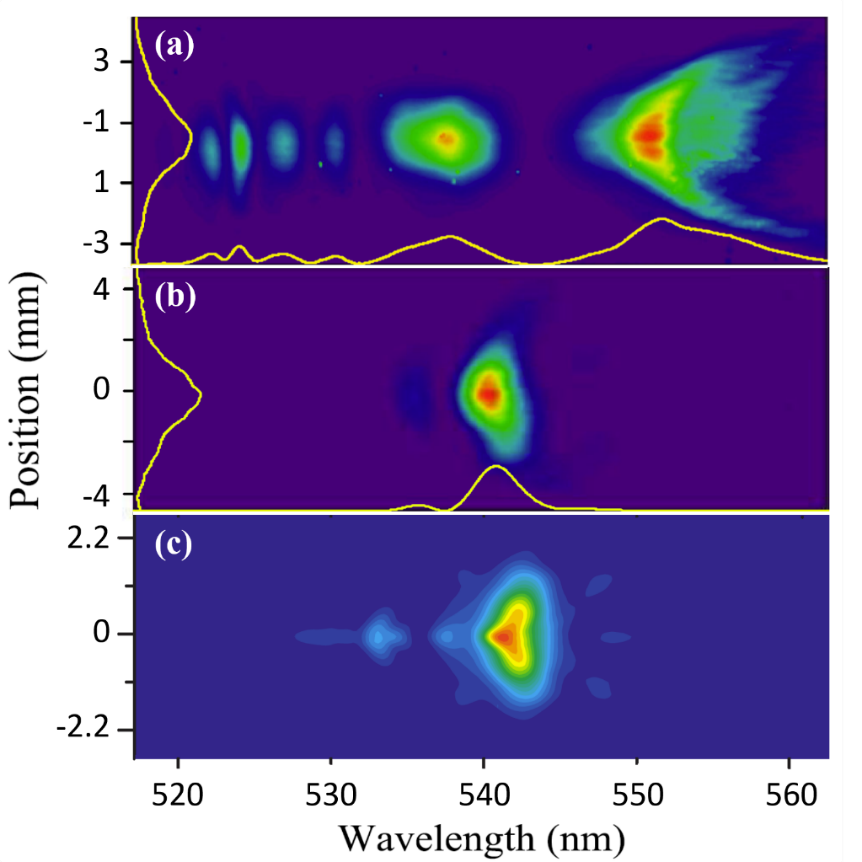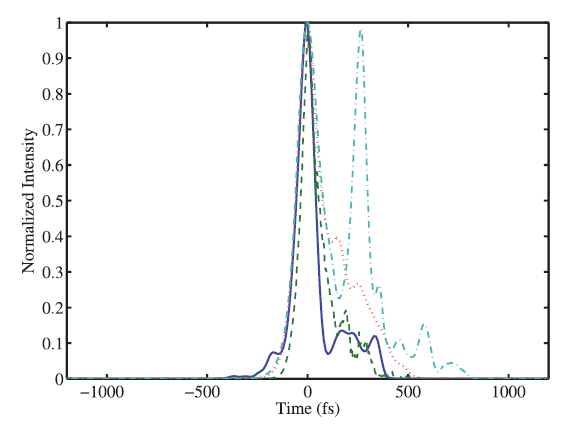SASE FEL with an Energy-Chirped Electron Beam and Undulator Tapering (2010)
The experiment has been carried out to reach the single spike regime, even with an electron bunch larger than the cooperation length, with using a linearly chirped electron beam and an undulator tapering in order to force to emit a single region of the beam initiated in the rear of the bunch as it moves forward in the bunch coordinate with the appropriate velocity.
This is the first experimental demonstration, at the SPARC_LAB FEL test facility, of the generation of short pulses in a single pass amplifier with this combined chirp-taper method.
The accelerator provides a high quality beam. Electron bunch is compressed longitudinally by means of the velocity bunching with the injection in the first Linac section close to the zero-crossing phase. This gives to the beam a strong chirp in the longitudinal phase space with an increase of the peak current. The complete list of the electron beam parameters is detailed in Tab. I.
| Beam energy | 115.2 MeV |
| Projected energy spread | 1.33 MeV |
| Chirp | -8.7 keV/µm |
| Slice energy spread | 0.7 MeV |
| Bunch length (rms) | 0.42 ps |
| Beam current | 380 A |
| Vertical emittance | 2.7 mm mrad |
| Horizontal emittance | 3 mm mrad |
| Twiss βx,y (average in undulator) | 1.5 m |
Tab. I – Electron beam parameters for the experiment.
When all undulator modules are tuned at the same nominal resonant wavelength (540 nm) with no tapering in the undulator, the strong given chirp in the electron bunch causes a broadband spectrum for the FEL radiation. With undulator tapering, to compensate the chirp, an increase of the pulse energy occurs together with a narrowing of the spectrum (see Fig.1). Relevant radiation parameters for both cases are compared in Tab.II.
| Untapered undulator | Tapered undulator | |
| Wavelength | 540 nm | 540 nm |
| Pulse energy | 7.8 µJ | 139 µJ |
| Line bandwidth (rms) | 8.8. nm | 4.3 nm |
Tab. II – Measured parameters of the output FEL radiation.

Figure 3: Single shot spectrum acquired by the high-resolution in-vacuum spectrometer, (a)with all undulators set at nominal resonance of 540 nm, (b) single spike spectrum after the undulator tapering, (c) simulation with GENESIS 1.3. The vertical axis represents the non dispersive dimension at the slit of the spectrometer.
Pulse duration measurement with TG-FROG
Temporal profile of an electron beam in conditions similar to what described before (see Tab.III), has been measured, once tapered the undulator, by means of a single shot Transient-Gating Frequency-Resolved Optical Gating (TG FROG) used for the first time in the FEL context. TG FROG is limited in the range of detectable wavelength in the IR and visible spectral but it fits well with the SPARC FEL possible spectral range (from IR to UV). Observation of this phenomenon is not possible at x-ray wavelengths because of the lack of appropriate diagnostics. As results, the FWHM pulse length of the dominant single spike is around 100 fs.
| Beam energy | 113.1 MeV |
| Beam charge | 250 pC |
| Chirp | -2.5 keV/µm |
| Slice energy spread (rms) | 5 x 10-3 |
| Bunch length (rms) | 0.42 ps |
| Beam current | 264 A |
| Vertical emittance | 2.3 mm mrad |
| Horizontal emittance | 1.6 mm mrad |
| Twiss βx,y (average in undulator) | 1.5 m |
| Undulator parameter K | 1.31 |
| Radiation wavelength | 530 nm |
| Max rad. energy | 31.5 µJ |
| Gain length | 92 cm |
| Pulse duration | 98 fs |
Tab. III – Set of beam and FEL pulse parameters in the TG-FROG-measurement case.

Figure 4: Comparison of the (a) experimental, (b) reconstructed, and (c) simulated FROG traces.

Figure 5: Comparison between the reconstructed intensity (solid-blue), simulated power at the FROG mask (dashed-green), total pulse simulated power (dotted-red), and total pulse simulated power in the absence of an undulator taper (dotted/dashed-turquoise).
References
– “Experimental Demonstration of Emittance Compensation with Velocity Bunching”, M. Ferrario et al., Phys. Rev. Lett., vol. 104 (2010), pag. 054801, doi: 10.1103/PhysRevLett.104.054801
-“Self-Amplified Spontaneous Emission Free-Electron Laser with an Energy-Chirped Electron Beam and Undulator Tapering”, L. Giannessi et al., Phys. Rev. Lett., vol. 106 (2011), pag. 144801, doi: 10.1103/PhysRevLett.106.144801
– “Time-domain measurement of a self-amplified spontaneous emission free electron laser with an energy-chirped electron beam and undulator tapering”, G. Marcus et al., App. Phys. Lett., vol. 101 (2012), pag. 134102, doi: 10.1063/1.4754612
SASE experiments

